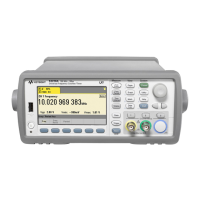10.
The 53131A/132A SENSe:ROSCillator:EXTernal:CHECk command controlled whether the instrument
would detect and report errors if the external reference signal was not present at the end of a meas-
urement. The 53220A/230A always detect this condition and report errors. The 53131A/132A com-
mand is accepted by the 53220A/230A, but has no effect on the instrument.
11.
The 53131A/132A SCPI macro capability is not supported, including the *DMC, *EMC, *EMC?, *GMC?,
*LMC?, *PMC, MEMory:DELete:MACRo, and MEMory:FREE:MACRo? commands.
12.
The 53220A/230A do not include an RS-232 port, and do not support hard copy output. The asso-
ciated HCOPy:CONTinuous and SYStem:COMMunicate:SERial subsystem SCPI commands of the
53131A/132A are accepted by the 53220A/230A, but have no effect on the instrument.
13.
The 53131A/132A DIAGnostic subsystem commands are not supported.
14.
Front panel menus are disabled when the 53131A/132A compatibility mode has been selected.
15.
Due to significant hardware differences between the 53220A/230A and the 53131A/132A, the cal-
ibration procedure and some of the CALibration subsystem commands are different.
16.
The 53131A/132A SYSTem:KEY and SYSTem:KEY:LOG? commands are not supported.
17.
When 50 ohm input impedance is selected, the 53131A/132A and the 53220A/230A specifications
limit the input voltage to 5 Vrms to prevent damage to the input termination resistor. If higher voltage
is present, 53220A/230A automatically switch the input impedance to 1 Mohm to prevent damage; the
53131A/132A has no such protection. If the automatic protection is triggered on the 53220A/230A,
you will need to send the 53131A/132A INPut{1|2}:IMPedance SCPI command to reset the input imped-
ance to 50 ohms.
DHCP
Short for Dynamic Host Configuration Protocol, a protocol for assigning dynamic IP addresses to devices on a network. With
dynamic addressing, a device can have a different IP address every time it connects to the network.
DHCP
Short for Dynamic Host Configuration Protocol, a protocol for assigning dynamic IP addresses to devices on a network. With
dynamic addressing, a device can have a different IP address every time it connects to the network.
Condition Register
A condition register continuously monitors the state of the instrument. The bits in the condition register are updated in real
time and the bits are not latched or buffered.
Condition Register
A condition register continuously monitors the state of the instrument. The bits in the condition register are updated in real
time and the bits are not latched or buffered.
Enable Register
An enable register defines which bits in the event register will be reported to the Status Byte register group. You can write
to or read from an enable register.
Event Register
An event register latches the various events from the condition register. There is no buffering in this register; while an event
bit is set, subsequent events corresponding to that bit are ignored. This is a read-only register.
Definite-Length Block Data
Definite-length block response data allows any type of device-dependent data to be transmitted as a series of 8-bit binary
data bytes. This is particularly useful for transferring large quantities of data or 8-bit extended ASCII codes.
Line Terminator
<NL> = New Line or Line Feed (ASCII decimal 10)
Keysight 53220A/53230A Programmer's Reference 497
Agilent 53131A/132A Compatibility Mode

